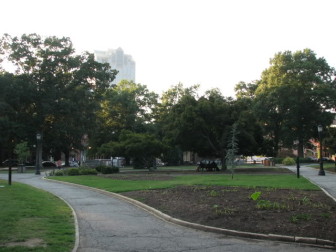In April 2011, more than a year after winning Raleigh’s Moore Square Redesign Contest, Christopher Counts received a surprising piece of news from the North Carolina Board of Landscape Architecture – because neither he nor his firm was licensed in the state, he was to immediately cease and desist any and all work on the project.
The initial legal issues with the question over licensing have since been cleared up, but now a second complaint is delaying work on the Moore Square redesign. The team working on the project is now waiting for a ruling from the NCBLA so they can get back to work.
Although North Carolina statutes prohibit any individual or firm without the requisite licensure from practicing their services in the state, the language does not explicitly state whether a license is required for the earliest, master-planning stages of a project, which is what Counts had been hired to create.
Both Counts and the city — as confirmed by Chief Planning and Development Director Mitchell Silver — had interpreted the law to mean that a licensed landscape architect is required only for the construction document phase. That’s the final point of the design process before drawings are approved for construction.

The NCBLA reached a different conclusion. In March of 2012, following a year-long investigation into Counts and the Moore Square project that included the hiring of a private detective, it determined that Counts was, in fact, in violation of the state statutes.
“We were all operating under commonly understood design industry standards,” which do not typically require registration, or licensure, in the earliest stages of design, Counts said. “Once we became aware of this very unusual interpretation, we immediately obtained the proper licensing.”
In June of 2012 Counts’ firm, Christopher Counts Studio, based out of New York, was registered as a corporation in North Carolina under the name CCSGC, PC. By July, the firm had obtained its license to practice landscape architecture in North Carolina
Jean Kirk, the continuing education coordinator with the NCBLA, explained that as long as someone high up in the firm – an officer or director, for example, someone with “skin in the game” – has their state license, the firm is then eligible to obtain a general license and able to practice landscape architecture within the state.
Additionally, the board on April 12, 2013 issued a report titled “Scope and Practice of Landscape Architecture” that appears to contradict its initial ruling against Counts.
The document states, that “conceptual/master plan work does not require, nor should it involve, the affixing of a seal or the observation and supervision of non-licensed landscape architects by a licensed Landscape Architect. In fact, many consultants, some licensed (e.g. architects and engineers) and some not (e.g. planners, urban designers, landscape designers and unlicensed graduates of landscape architecture programs) are able to produce master plans and conceptual site plans.”

In the case of CCSGC, PC in North Carolina, Runit Chhaya, who is listed as one of the company’s incorporators and who Counts describes as a business partner, has had his NC Landscape Architecture License since May of 2012.
In theory, this meant the project was free to continue moving forward, and it did so in the form of an initial tree and soil study that was completed in April of 2013.
In practice, Counts’ dealings with the Landscape Architecture Board were far from over.
A Local “Curmudgeon”
When the board sent its initial cease and desist letter to Counts in April 2011, it was the direct result of a complaint filed by semi-retired local landscape architect Michael Gibbons, who has previously worked for both WSP Sells and Bobbit Design Build.
Gibbons, who wryly describes himself as a “curmudgeon” and “a bit of a conspiracy guy,” said he first became aware of Counts’ lack of licensure after attending a lecture at NC State in early 2011 where Counts was announced as an upcoming guest lecturer.
“Something about the introduction of him, made me think, maybe he doesn’t have a license, so I looked him up,” Gibbons said.
“He didn’t have a license, so I filed a complaint with the Board of Landscape Architecture.”
This was not Gibbons’ first time filing a complaint with the board – nor would it be his last.
In 2008, while still under the employ of WSP Sells, Gibbons spent a significant amount of time trying to convince his bosses that the firm was in direct breach of the same statutes he would later charge Counts with violating. After months of inaction, Gibbons felt compelled to bring his concerns to the State Board of Landscape Architecture, as he was concerned he might lose his own license as a result of his employer’s mistakes.
According to a wrongful termination suit filed against WSP Sells in October of 2009, Gibbons brought his concerns to the board on May 12, 2008. A meeting with the board’s attorney was scheduled for May 16, 2008. The same day of the scheduled meeting, Gibbons was terminated by WSP Sells due to a “lack of work.”
The suit against WSP Sells was eventually settled. Gibbons says he cannot comment on the terms of said settlement.
When the original complaint against his former employer resulted in only “nominal action” taken against them by the NCBLA, Gibbons in March 2012 filed another lawsuit – this time against Stanley Williams, the board’s vice-chair.
On July 25, 2013 the case was continued pending a resolution of Williams’ motion to dismiss.
No Dog in the Fight
Gibbons said he realized his past history may cause some to question the motivation or reasoning behind his complaints against Counts. He explained that his actions – which have also included complaints, later dismissed, against a number of North Carolina State University professors of landscape architecture who do not have active licenses – are merely his way of protecting the integrity of his profession.

Moore Square. Photo by Leo Suarez.
“[Non-landscape] Architects are famous for going after people with teeth bared” for practicing without a license, he said.
“My opinion is if the board and the state and the city come down on Counts, suddenly, everyone who thinks about practicing without a license thinks twice,” Gibbons added.
Second Complaint
When he learned that Counts and his team were still continuing with the project despite the board ruling against them, Gibbons said he filed a second complaint in May of 2013, alleging the same violation of the same statutes he had accused Counts of breaking the first time around.
The complaint is currently under review by the Board of Landscape Architecture, and the city cannot move forward until a determination is made.
Cassie Schumacher-Georgopoulos, a senior planner with the city of Raleigh’s Parks and Recreation department, said the project is now on hold both as a result of the complaint and a lack of funding for construction. Further planning, however, would likely be able to move forward once the complaint is resolved. The next stage, she said, is schematic design.
Without Merit
Counts has worked on a variety of public park projects in the past, including the master plan for the Brooklyn Bridge Park in New York.
“It’s not unusual that public projects have challenges – I’ve worked on many,” he said.
“It’s challenging, and that’s kind of the beauty and also the frustration of working within the public realm, an opportunity to really improve the daily lives of so many people.”
He described the licensure issues that have come about as a result of the Moore Square planning process, however, as “very unusual.”
The repeated complaints, he said, were “malicious accusations without merit.”
Counts stopped short of issuing any personal criticisms of Gibbons or the board, however.
“I’m not going to say anything bad about anybody – I just want to give the facts about how great this project is, and how great it can be for the city and the people of Raleigh,” he said.
More than anything, Counts said he is eager to get back to work on the park, which he said could become a “world-class destination” for the city.
He added that he was proud of the work done so far, and that outside of Gibbons, there have not been a significant amount of complaints or issues with his design. In fact, he added, the design was recently selected to receive a significant industry award, although this will not be announced officially until late September or October.
